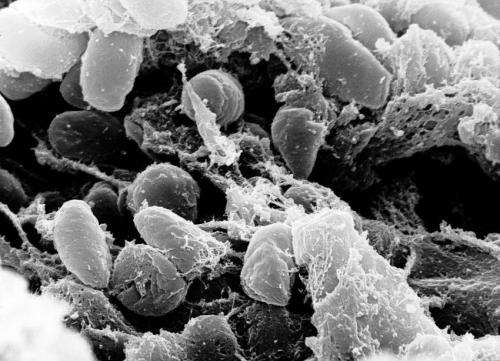December 2, 2014 report
Research pair learn how plague bacterium adapted to help fleas pass on disease

(Phys.org)—A pair of researchers with NIH has discovered the evolutionary path that a bacterium that causes the plague took to allow for transmission via fleas. In their paper published in Proceedings of the National Academy of Sciences, Iman Chouikha and Joseph Hinnebusch describe how they studied the bacterium and its genes to learn how it adapted to become less lethal to fleas and thus better able to infect more hosts.
The plague, as most are aware, has a deadly history—it's killed millions of people over time and still today evokes fear when mentioned. Scientists have known for some time that the reason it was so deadly was because of the easy transmission route, from fleas to rodents and humans. But fleas, it turns out, weren't always such great carriers, the researchers with this new effort learned. In fact, the bacteria had to evolve to be less harmful to fleas so that they could be better carriers.
The research pair actually studied two types of bacteria, Yersinia pseudotuberculosis and Yersinia pestis. The former is relatively harmless in that it's not a good carrier of plague. The later is the real culprit. Prior research has shown that Y. pseudotuberculosis appears to be a representation of what Y. pestis used to be, thus, to learn how the bacterium evolved to take better advantage of fleas, the team needed to look at how the two types differed.
They found that while Y. pseudotuberculosis colonizes just the end of the flea digestive track, Y. pestis forms a film from one end to the other. The former makes it more difficult to infect a host, but is more toxic to the flea as it causes death in almost half of those that are infected. Further research revealed that the bacterium needed to develop just a single gene to allow for growing deeper in the GI tract and had to lose three that hindered the spread of a film. They also discovered the gene change that caused the bacteria to be less toxic to the flea: UreD.
Taken together, these simple genetic changes allowed the bacterium to harness the carrier strength of fleas which ultimately led to the deaths of millions of people over many years from the dreaded plague.
More information: Silencing urease: A key evolutionary step that facilitated the adaptation of Yersinia pestis to the flea-borne transmission route, PNAS, Iman Chouikha, DOI: 10.1073/pnas.1413209111
Abstract
The arthropod-borne transmission route of Yersinia pestis, the bacterial agent of plague, is a recent evolutionary adaptation. Yersinia pseudotuberculosis, the closely related food-and water-borne enteric species from which Y. pestis diverged less than 6,400 y ago, exhibits significant oral toxicity to the flea vectors of plague, whereas Y. pestis does not. In this study, we identify the Yersinia urease enzyme as the responsible oral toxin. All Y. pestis strains, including those phylogenetically closest to the Y. pseudotuberculosis progenitor, contain a mutated ureD allele that eliminated urease activity. Restoration of a functional ureD was sufficient to make Y. pestis orally toxic to fleas. Conversely, deletion of the urease operon in Y. pseudotuberculosis rendered it nontoxic. Enzymatic activity was required for toxicity. Because urease-related mortality eliminates 30–40% of infective flea vectors, ureD mutation early in the evolution of Y. pestis was likely subject to strong positive selection because it significantly increased transmission potential.
Journal information: Proceedings of the National Academy of Sciences
© 2014 Phys.org

















